The Brezhnev Era in Western Caricatures
Concluding the theme of the anniversary of the beginning of the era of Leonid Brezhnev (in October 1964 he was elected First Secretary of the Central Committee of the Communist Party of the Soviet Union) there is a selection of Western caricatures about the most noticeable, in the artists’ opinion, events of the Brezhnev era. The main author is the German-Dutch cartoonist Fritz Behrendt (1925-2008).
1. Brezhnev becomes the first (October 14, 1964)
On October 14, 1964, the plenum of the Central Committee of the CPSU dismissed N.S. Khrushchev “due to old age and deteriorating health.” Leonid Ilyich Brezhnev became the first secretary of the Central Committee.
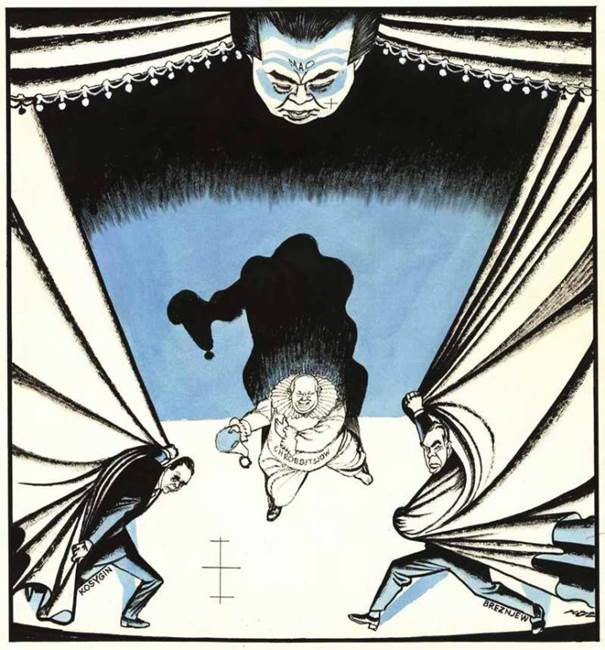
In the drawing, Kosygin and Brezhnev close the curtain after Khrushchev’s performance, presented as a clown. From above, Mao looks on impassively.
2. 50th Anniversary of October (1967)
On November 7, 1967, the 50th anniversary of the October Revolution of 1917 was solemnly celebrated in the USSR. This holiday was overshadowed by the deterioration of relations with the People’s Republic of China, which began under Khrushchev.
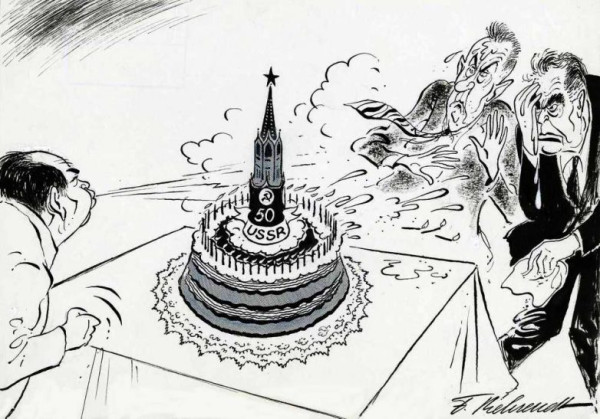
In the picture: Mao Zedong spoils the 50th anniversary of the October Revolution for the masters of the Kremlin (Brezhnev and Kosygin).
3. The Six-Day War in the Middle East (1967)
In June 1967, a war broke out in the Middle East between Israel on the one hand and the Arab countries (Egypt, Syria, Jordan, Iraq and Algeria) on the other. It lasted six days and ended with Israel’s victory. Brezhnev commented on the course of the war in his circle as follows: “In the Suez Canal we have already been dipped in the face. Soon it will be the turn of the Nile. We have so many advisers in the Egyptian army. They didn’t give a damn piece of advice, just as our schools didn’t teach the Egyptians. Instead of taking the fight… When they see an Israeli plane, they eject.” At the same time, the Soviet Union severed diplomatic relations with Israel.
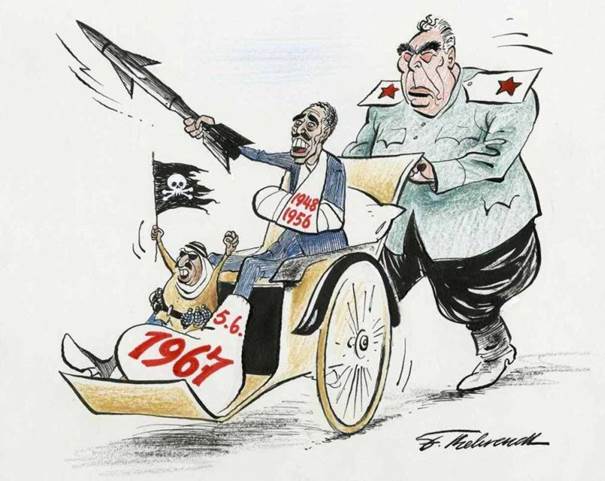
PLO leader Yasser Arafat, Egyptian President Anwar Sadat, and Brezhnev after the 6-day war in the Middle East
4. The Prague Spring and the Soviet Invasion (1968)
On August 21, 1968, troops of the USSR and other Warsaw Pact countries entered Czechoslovakia to stop the process of liberal reforms initiated by the Czechoslovak leadership led by Alexander Dubček, the Prague Spring.
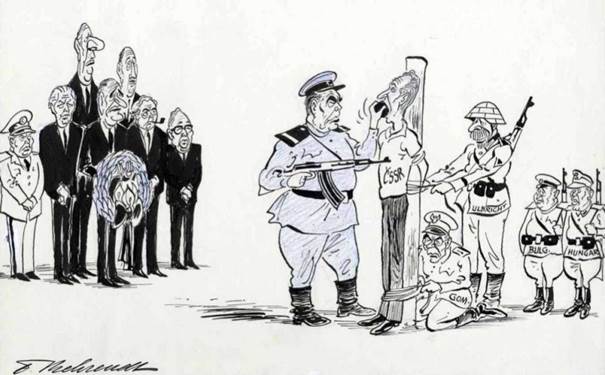
“With a feeling of sincere sympathy.”
In the drawing, Brezhnev inserts a gag into Dubček, the leaders of the GDR and Poland, Ulbricht and Gomułka, help tie him, and the Western countries and Yugoslavia prepare a tombstone.
5. Conflict with China (1969)
In 1969, the deterioration of relations between Moscow and Beijing reached one of its lowest points, reaching border military clashes over Damansky Island.
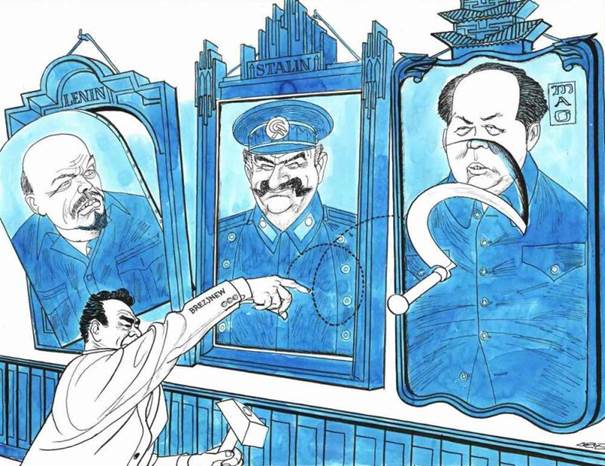
“Maoism now appears to be the greatest threat to Soviet communist leaders.”
In 1972, U.S. President Richard Nixon made his first official visit to China and agreed to begin normalizing relations between the two countries. This caused concern in the Kremlin as the possibility of a US-Chinese alliance against the USSR.
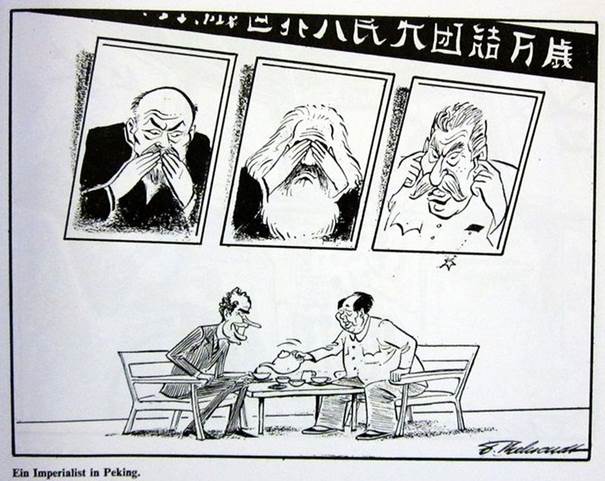
“The Imperialist in Peking.”
6. Opening of the Aswan Hydroelectric Power Station (1971)
On January 15, 1971, Egyptian President Anwar Sadat and Soviet President Nikolai Podgorny inaugurated the Aswan Hydroelectric Power Station, created with the help of the USSR. Cooperation between Egypt and the Soviet Union caused alarm in the West.
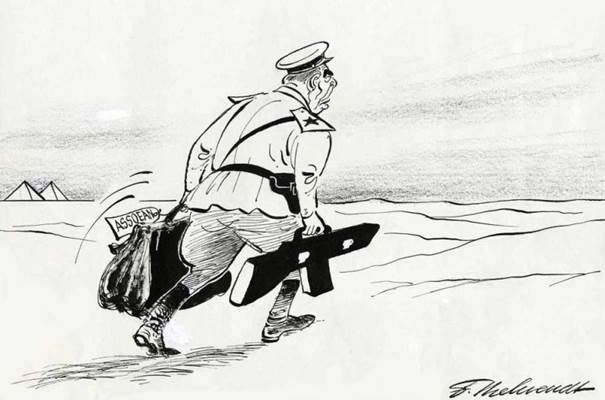
“Voyage to Egypt”.
In the picture, Brezhnev travels to Egypt under the pretext of building the Aswan High Dam, but in fact he is carrying weapons there.
7. Détente (1970s)
After the failure of the Prague Spring, the West began a process of “détente” with the USSR. Its guides were Richard Nixon and West German Chancellor Willy Brandt. In 1971, Brandt received the Nobel Peace Prize for this.

“A New Image in Moscow – and in East Berlin?”
Brezhnev replaces the old portrait of Brandt in the USSR as a hawk of war, militarism and revanchism with a new one – as a messenger of peace, with a Nobel medal on his chest.
The Other Side of Détente (Brezhnev and Kissinger):
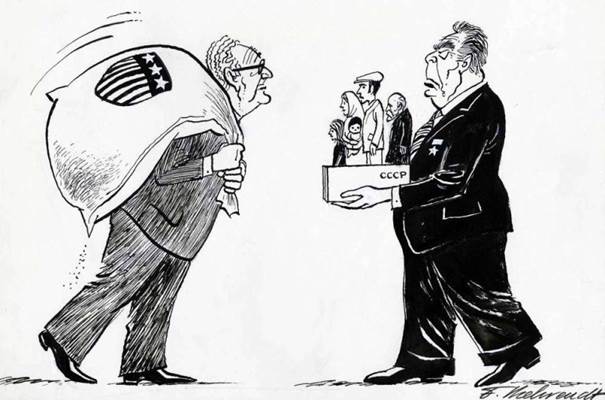
“The trade turnover is American money in exchange for the possibility of emigration of Soviet Jews.” Drawing from 1975
And even so:
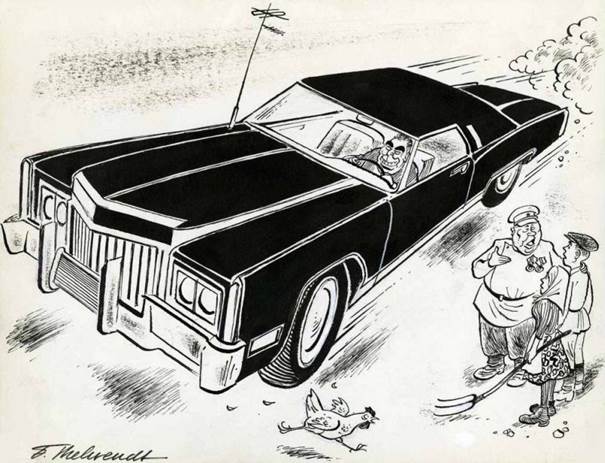
“In a modern high-speed car, Leonid can very quickly evacuate to the capitalist hell in case of any threats to him inside the country.” Drawing from 1973
But this is most likely a strong exaggeration of the situation at that time: Brezhnev did not plan to “evacuate to capitalist hell” under any circumstances.
8. Indo-Pakistani War (1971)
In December 1971, the Third Indo-Pakistani War took place. It ended in a major defeat for Pakistan, and East Pakistan eventually gained independence as a new state, Bangladesh. The USSR supported India in this conflict, and the United States supported Pakistan.
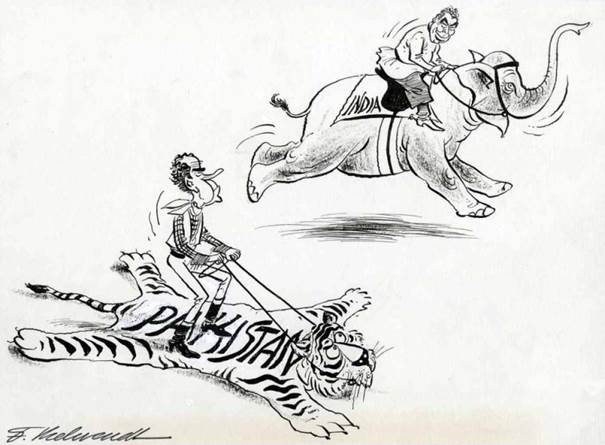
“How Brezhnev Outwitted Nixon.”
9. The Yom Kippur War (1973) and Its Aftermath
In October 1973, another war broke out in the Middle East between Israel and the Arab countries, at the beginning of which Israel suffered setbacks, but then managed to turn the tide of hostilities in its favor. Brezhnev’s comment in his circle on the course of the war: “For many years we have been offering them [the Arab countries] a reasonable way. No, they wanted to fight. Please, we gave them the latest equipment, which was not available in Vietnam. They had double superiority in tanks and aircraft, triple superiority in artillery, and absolute superiority in anti-aircraft and anti-tank weapons. So what? They were gouged out again. And again they dragged. And again they screamed for us to save them. Sadat picked me up to the phone twice in the middle of the night. He demanded that I immediately send a landing force, etc. No! We will not fight for them. The people won’t understand us. And I’m not going to start a world war because of them. That’s it.”
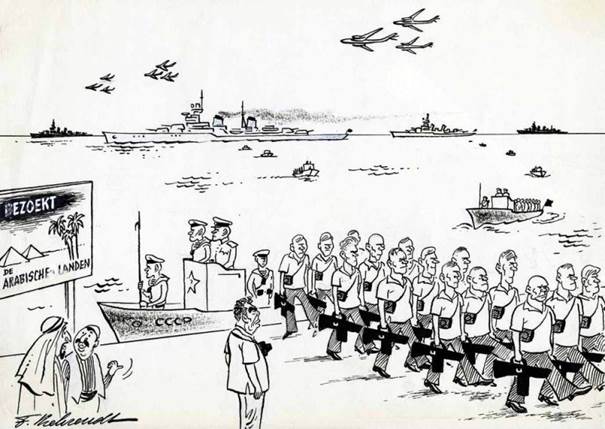
“Brezhnev and Soviet Tourists in the Middle East”. Drawing from 1974
One of the consequences of the war was the “oil crisis” of 1973, when it is believed that “Arab sheikhs took the West by the throat” by cutting off oil supplies to the United States and other countries that supported Israel. As a result, the price of oil rose from $3 to $12 per barrel, and Western countries had to reduce their use of fuel.
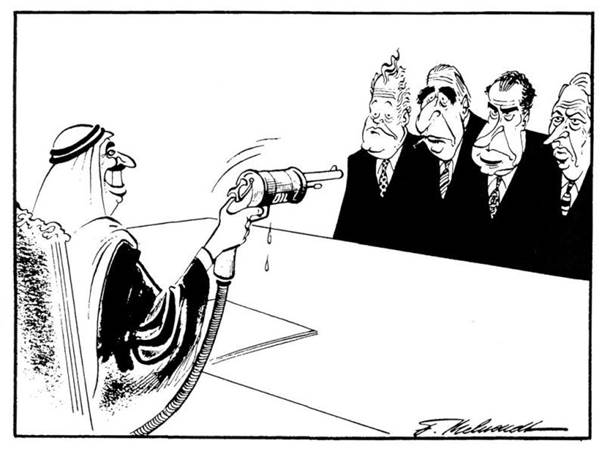
“Oil crisis”. Drawing from 1973
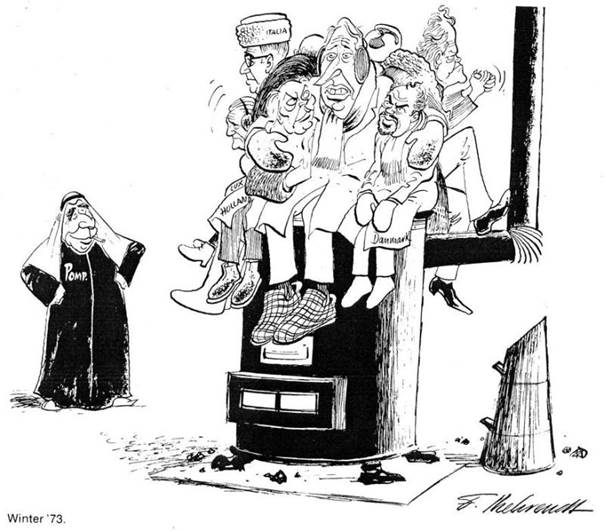
Winter 1973.
The frozen Western countries in the picture are warming themselves on the stove, the Arab sheikh (or Brezhnev in Arab costume) is triumphant.
However, under the influence of all these events, in the mid-1970s, Egyptian President Sadat changed his orientation and instead of friendship with the USSR, he chose an alliance with America and the West. For him personally, it culminated in his assassination in 1981 during a military parade.
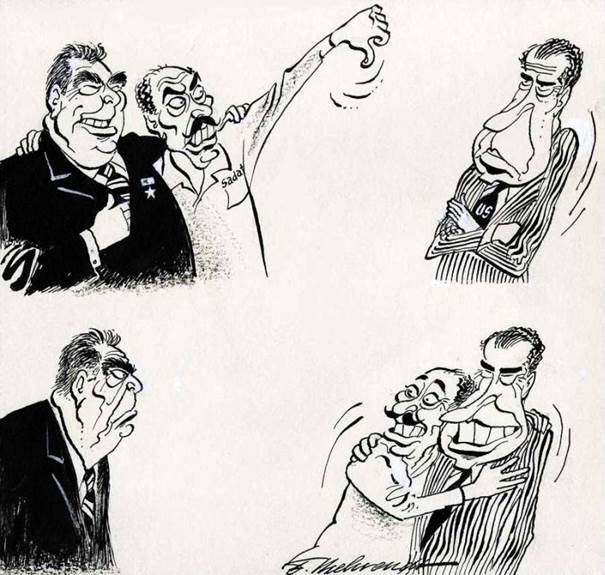
“The Evolution of Egyptian President Sadat’s Friendship from 1971 to 1975.”
10. Expulsion of Solzhenitsyn (1974)
On February 12, 1974, the writer Alexander Solzhenitsyn was arrested and exiled from the USSR the next day. This happened in connection with the publication in the West of his work “The Gulag Archipelago”, which sharply condemned the Soviet system.
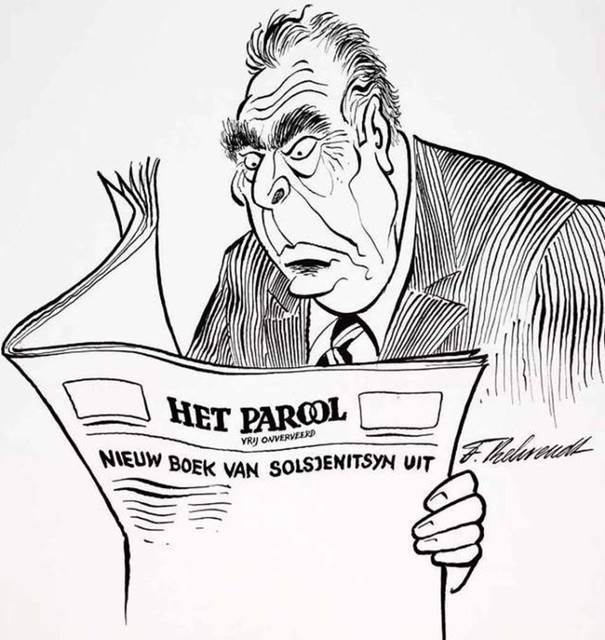
“Brezhnev reads with horror a report in a Western newspaper about the publication of Solzhenitsyn’s new book.” Year 1974
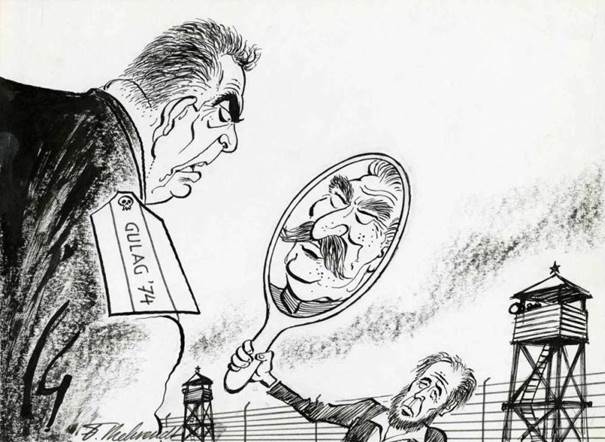
The Gulag. Year 1974
Solzhenitsyn shows Brezhnev in the mirror his reflection in the form of Stalin.
10. Vietnam War (until 1975)
Until 1975, the war in Vietnam continued – between North Vietnam, which was supported by the USSR and China, and South Vietnam, where American troops were stationed. The war ended on April 30, 1975, with the fall of the South Vietnamese capital, Saigon, and the evacuation of U.S. troops. A year later, in July 1976, the unified Socialist Republic of Vietnam was proclaimed.
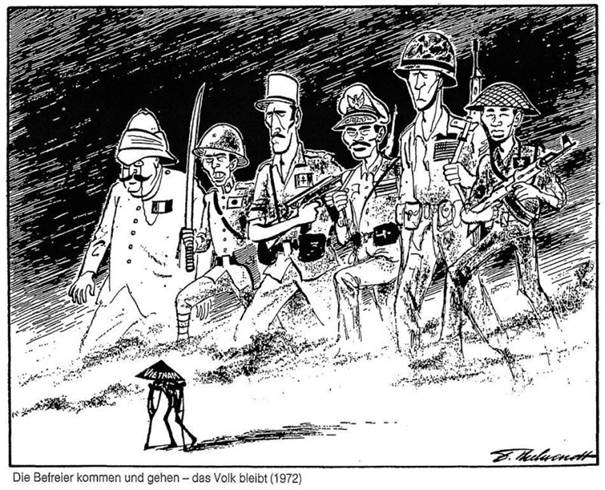
“Liberators come and go, but people stay.” Year 1972
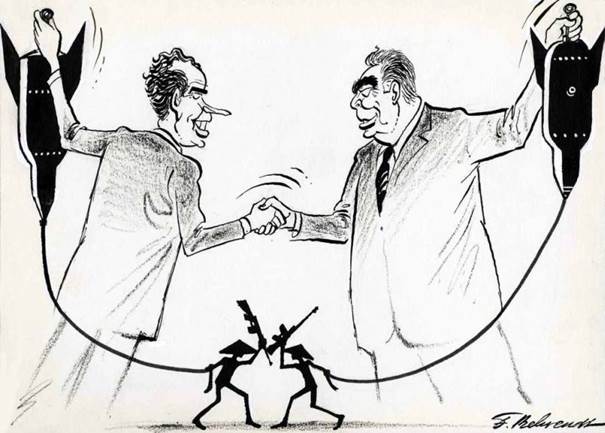
“Vietnam. The Process of Blood Transfusion”. Year 1973
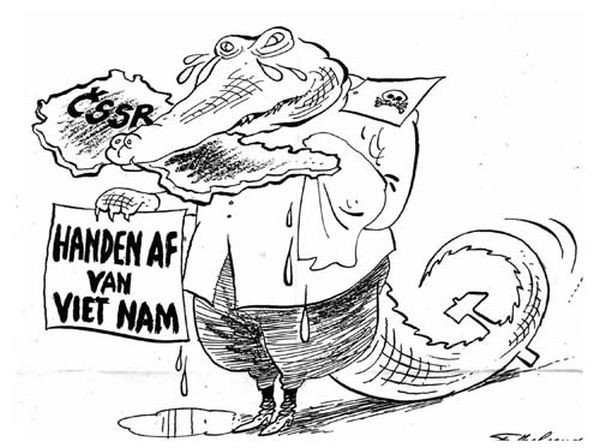
Holding Czechoslovakia in his mouth and shedding tears, the Soviet crocodile in the drawing holds a poster reading “Hands off Vietnam.”
11. 60th Anniversary of October (1977)
In 1977, the USSR celebrated the 60th anniversary of the October Revolution.
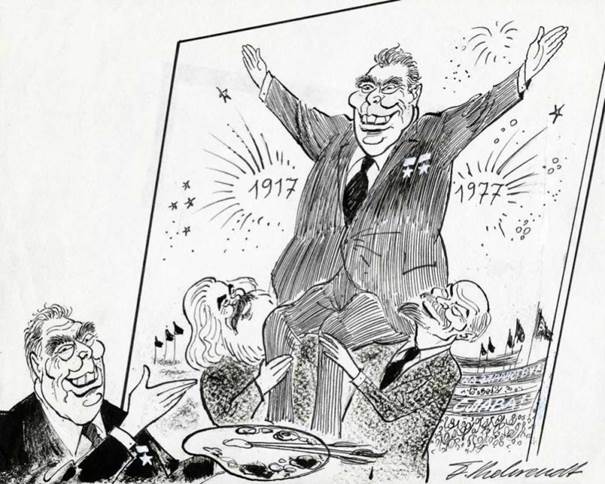
“Marx and Lenin congratulate Brezhnev on the 60th anniversary of the October Revolution.”
12. The Iranian Revolution (1979)
In 1978-1979, a revolution took place in Iran, during which Shah Mohammad Reza Pahlavi was overthrown and an Islamic republic was proclaimed. Left-wing forces, including the Communists, took an active part in the revolution in the early years.
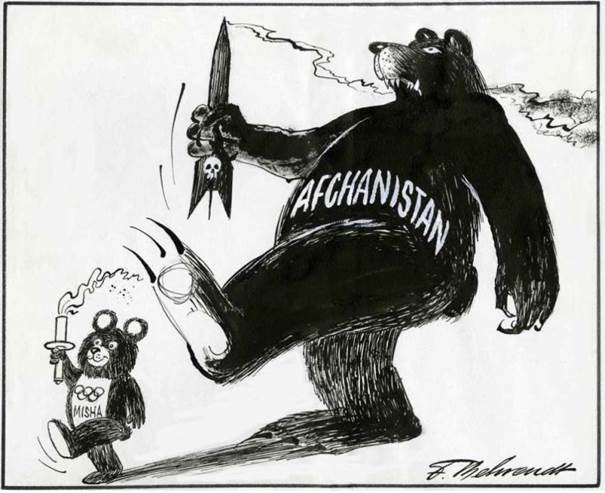
“Reza Pahlavi (Shah of Iran) – An Interrupted Flight on a Magic Carpet.” Year 1978
In the picture, U.S. President Jimmy Carter unsuccessfully tries to hold the Shah’s leg as he falls from a perforated flying carpet. They are followed by Ayatollah Khomeini and a rather smiling Brezhnev.
13. The Saur Revolution in Afghanistan (1978) and the Introduction of Soviet Troops (1979)
In April 1978, the Saur (April) Revolution took place in Afghanistan, as a result of which the communists came to power. The United States and Western countries deployed military support for the opponents of the revolution, and in December 1979 the USSR decided to send its troops to Afghanistan to counter them.
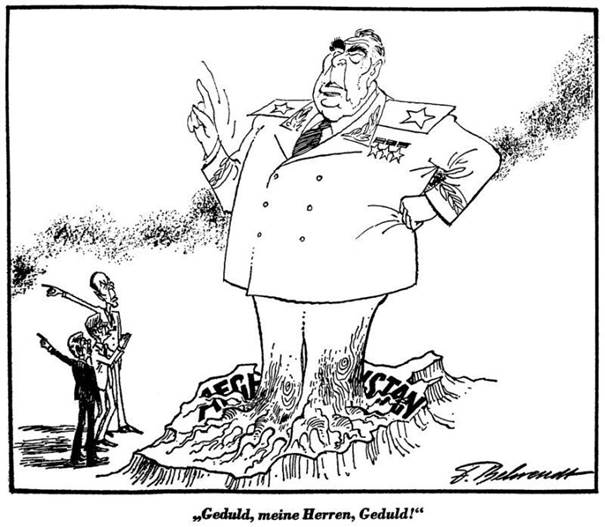
“Patience, gentlemen, patience!”
14. Sino-Vietnamese War (1979)
In February 1979, there was a war between two socialist countries, China and Vietnam. The USSR supported Vietnam in this war. The conflict arose due to the overthrow of the government of Democratic Kampuchea (now Cambodia) led by Pol Pot by Vietnamese troops.
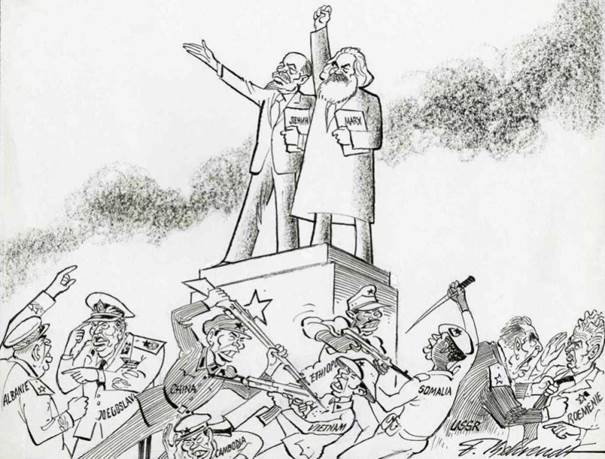
Communist Theory and Practice. Year 1979
In the picture, Albanian Communist leader Enver Hoxha argues with Yugoslav leader Josip Broz Tito, China fights Vietnam and Vietnam fights Cambodia, Ethiopia fights Somalia, and Brezhnev argues with Romanian leader Nicolae Ceausescu.
15. Olympics in Moscow (1980)
On July 19, 1980, the Summer Olympics opened in Moscow. The presence of Soviet troops in Afghanistan became a pretext for a number of Western countries to boycott the Olympics.
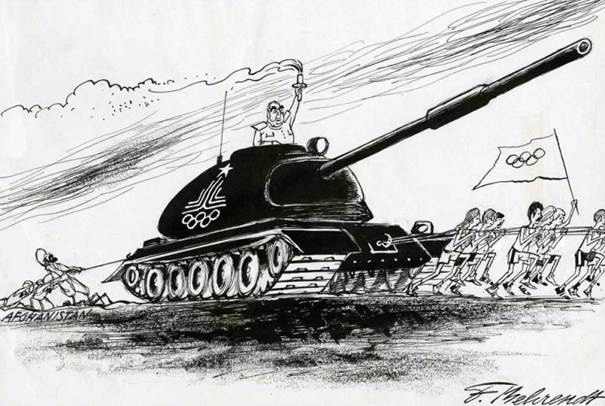
“The Olympic Games… with death.” Year 1979

Olympics. Year 1980
16. Martial law in Poland (1981)
On December 13, 1981, martial law was declared in Poland. It was caused by the activities of the Solidarity trade union, led by Lech Wałęsa. Later, in the late 1980s, the legalization of Solidarity led to the restoration of capitalism in Poland.
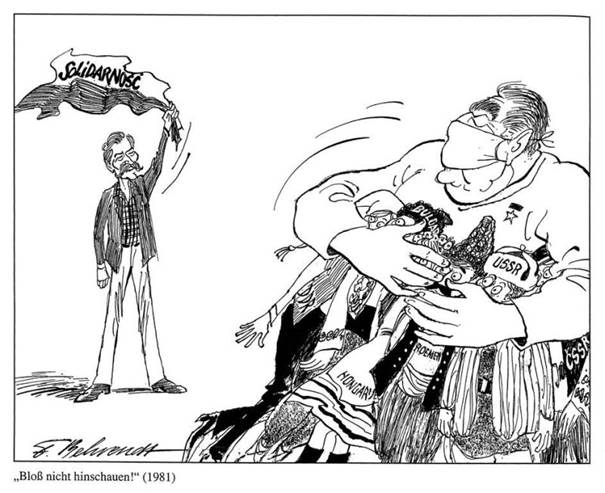
“Just don’t look!” Year 1981
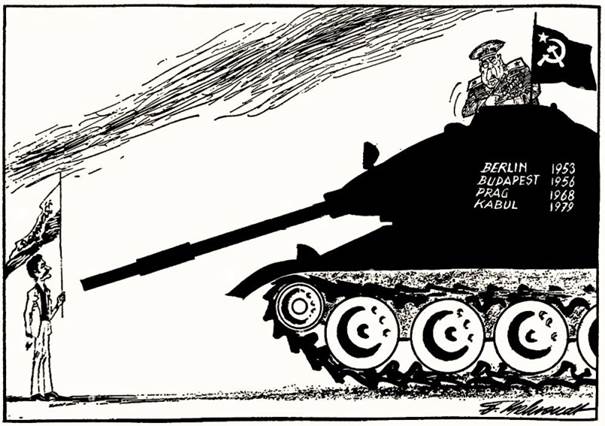
Brezhnev’s tank reads: “Berlin 1953, Budapest 1956, Prague 1968, Kabul 1979.”
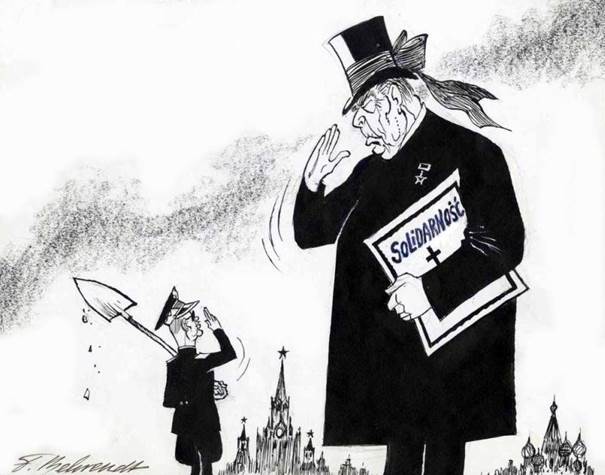
Brezhnev to Jaruzelski: “You have fulfilled your mission!” Year 1981
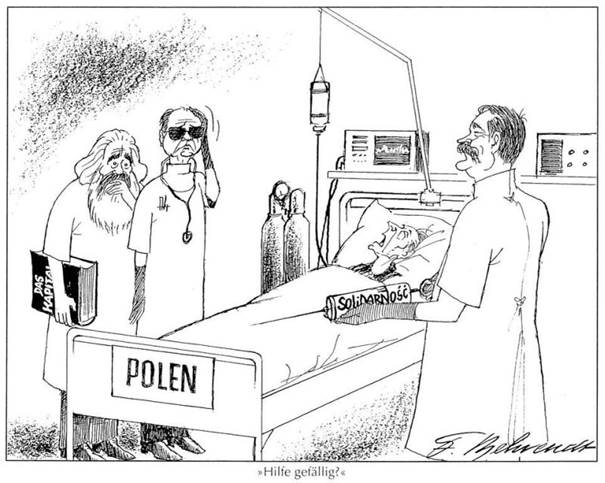
“Help is welcome!” Year 1986
Lech Wałęsa offers Poland a huge syringe with the inscription “Solidarity”, and a dejected Marx and Jaruzelski stand at the patient’s bedside.
